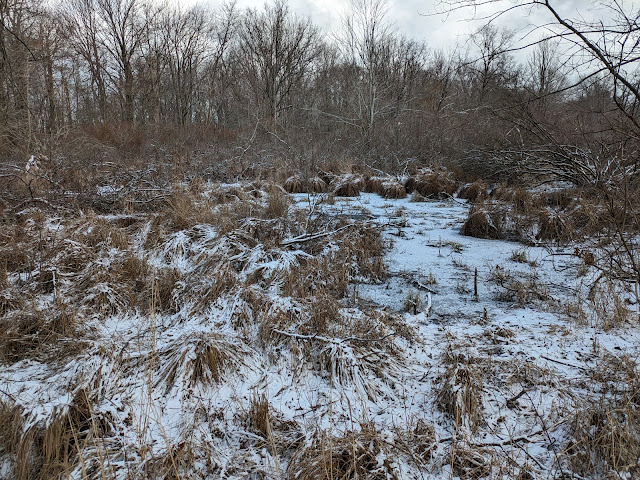One of the reasons I love winter hiking is that I can really see the structure and heart of a landscape. What makes one kind of place entirely inhospitable to certain flora and fauna may be the reason it is ideal for others. Presque Isle is a large curving sandspit that juts out into Lake Erie. It was great fun to explore in winter and to see how this unique place "fits the curve." Amos and I did a six mile loop hike through the interior sandspit under snowy/squally/windy skies.
 |
| Big winds drive sand over snow |
The sandspit that forms Presque Isle is a dynamic landscape feature that pushes out into Lake Erie a full two miles. It's built by longshore currents which keep the whole structure moving steadily north - despite engineering attempts to contain it. Gale force winds had blown through the night and upon our arrival to begin our hike, it was clear that a two-mile walk out on the exposed Gull Point would be uncomfortable for both of us so we began at the end and we did our hike in reverse. Sand blew steadily about on the exposed beaches across palustrine sand plains that emerge or submerge with fluctuating lake levels. It was amazing to hear the sand moving over snow. We then hiked into the forest to see what the interior held.
 |
| Presque Isle Lighthouse |
We hiked into a sheltered forest that borders an extensive Alder and Buttonwood swamp. Named the Sidewalk Trail, we followed the path that originally linked the Presque Isle Lighthouse to the once busy boathouse and life-saving station on the interior of Misery Bay. This site connects to the current U.S. Erie Coast Guard Station today. The scent of recent beaver activity excited Amos so much that he hollered a few times over the silent, frozen ponds. This shrubby wetland complex harbors hardwood edge forests of large Red Maple and mature Black Gum, fringed with Paper Birch, Black Oak, and Pitch Pine. Despite the driving winds on the beaches, the snow that had fallen during the night still laid gently along limbs and branches undisturbed by the morning gusts.
 |
| A gusty, cold day |
 |
| From Pope & Goreki (1982) |
As we hiked towards the Coast Guard Station, the wetlands changed in variety and size from shrub swamp to tussock marsh to bog and shallow ponds. A Red-Tailed Hawk soared over the floating cottages and another one hunted from the top of the station's entry gate. Beaver lodges stood high above the frozen pond surface with plenty of evidence of their winter work all around. The winds continued to roar over our heads while the rhythmic sound of lake waves crashing onto the shore surrounded us. But we were still protected from the wind. Blue skies opened then closed. Snow squalls enveloped us then moved on hide the City of Erie across the bay. Everything was in motion except for the quiet still wetland ponds and the paths we took behind the shoreline.
 |
| Big lake skies and wind |
 |
| Lighthouse supply path "Sidewalk Trail" |
The tussock sedge marsh communities something to see, patterned with snow and the lay of the sedges according to the prevailing winds. Someone in a recent workshop said that she loves exxploring Pennsylvania because there is so much here and I couldn't agree more. As we continued to wander all the interior trails I made a note in my sketchbook about not getting out to Gull Point and that if I wanted to this year, I'd have to make plans to return soon as the park will close the sandspit to humans when shorebird nesting season starts up again in April.
 |
| Tussock marsh |
One of many great conservation success stories is happening out on Gull Point. The endangered Piping Plover (Charadrius melodus) is staging a comeback on the Great Lakes, and here on the point and two pair of Piping Plovers established nests in 2017 - the first return to Pennsylavnia's shoreline since 1955. They've been back to this wide, sandy hook every year since and biologists are cautiously optimistic that with continued efforts to restrict access to the point during nesting season with trail closures our first recovered population will continue to grow.
 |
| U.S. Lighthouse Service Path |
Gull Point is the only Pennsylavnia breeding area for this once abundant Great Lakes species. During the 1950s and 1960s as massive housing and industrial landscape transformation impacted Lake Erie's sandy and pebble beach shores, populations of Piping Plover dropped from hundreds of pairs on Lake Erie alone to just fifteen pairs for all of the Great Lakes region and those found only on Lake Michigan shores.
 |
| Northern hardwood edge - White Birch |
In 2010 and 2011 the U.S. Fish and Wildlife Service, PA Game Commission, with other state and federal partners funded a two-year restoration of Gull Point at Presque Isle that included managing access to the point of beachgoers and boaters. By 2015, birders out on the Erie Bird Observatory (EBO) noted that Piping Plovers had returned to the sandspit to forage and have a look around. By 2017, they had established two nests! Now, hundreds of people excitedly await news of each year's current breeding/nesting status, though this past year was a REAL nail-biter! (See Notes)
 |
| Sand Barrens |
The interior trails closest to the leading edge of the curving sandspit featured many beautiful sand barrens and I'm sure when it warms up, there will be plenty of ground nesting bees to observe here. At one point we were the ones being observed as a Merlin perched in a stunted pine gave us a loud kee-kee-kee! This fierce little falcon was particulalry rankled that I stoppped to admire the field. At one point he rocketed straight up and hovered over the grass. With that, he plummeted down and snagged a sparrow! Oof! Time to move on so the Merlin could pluck his supper in peace.
 |
| Palustrine Grassland |
Another mile and we re-emerged at the parking area to Gull Point. The wind was still raging and even though we could have walked to the point, a large snow squall was about to engulf us. Back to the lighthouse we went, leaving Gull Point for another time. Hat tip to the EBO who keep such good wacth over Gull Point and are working to help re-establish the Great Lakes Piping Plover population in Pennsylvania.
 |
| Sand over snow |
 |
| Happy and tired Amos |
Notes:
Presque Isle is an ever-changing landscape feature no matter how hard we humans want it to stay put:
Pope & Goreki (1982) "Geologic and Engineering History of Presque Isle, PA"
The 2023 Gull Point Nesting Report was a real nail-biter! See this 2023 report by the Erie Audubon and Erie Bird Observatory (EBO) by Mary Birdsong, "The Agony and The Ecstacy"
The Erie Bird Observatory does some really amazing work in coastal PA with their monitoring and surveys. Thanks to all the birder volunteers who do this critical work.













































